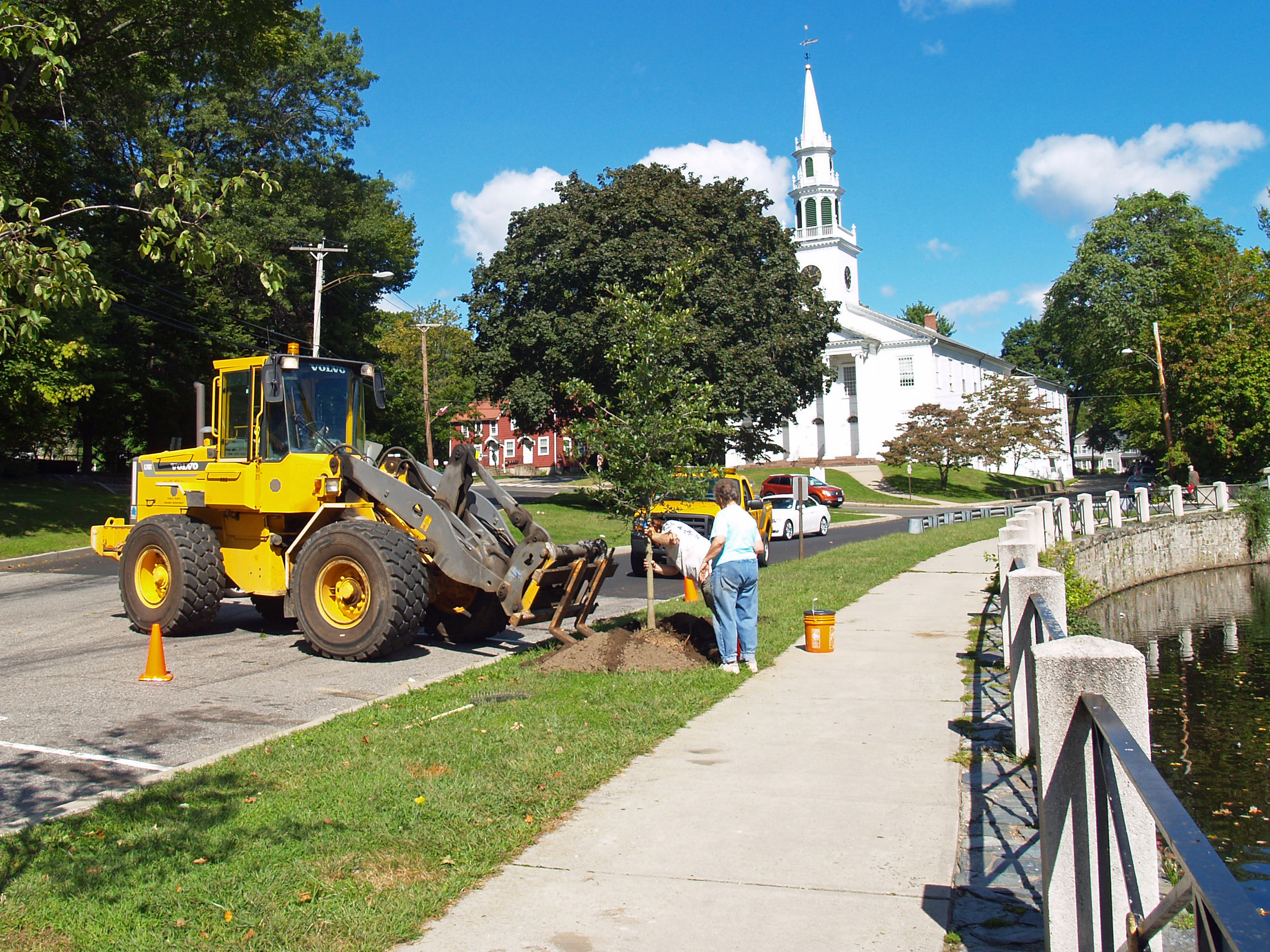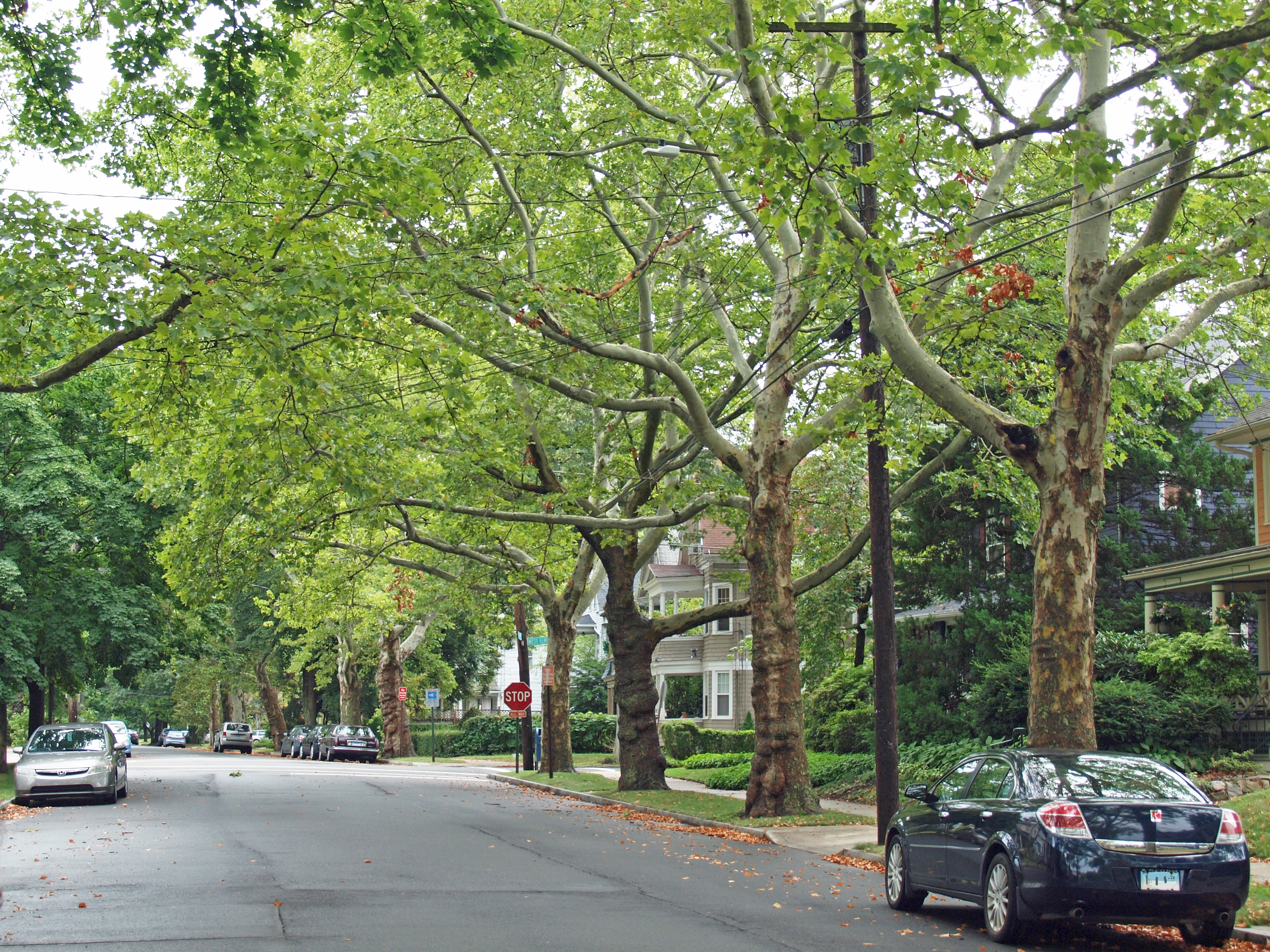City-Scale Urban Forest Management
Trees are a vital part of all cities and towns. In Connecticut, with the exception of trees in wetlands, trees on private property are usually not subject to the direct jurisdiction of the municipality. At the same time, trees in municipally-owned public spaces, such as along roads, in parks, or adjacent to public schools, usually are the responsibility of the municipality. These public trees place financial and legal obligations on the community as a whole. These trees need to be cared for, with management costs involved and the need for plans and policies to guide their care.
Residential street in New Haven lined with London plane trees.
State Laws Relating to Municipalities and the Urban Forest
CGS Sec. 7-131: Municipal Forests
Gives municipalities authority to establish municipal forests and a municipal forest commission.
CGS Sec. 7-131a: Conservation Commissions
Provides the authority to establish a conservation commission and defines the role of a conservation commission.
CGS Sec. 7-148: Scope of Municipal Powers
Describes the authorities of a municipality, including, in subsection (6)(A)(v), the authority to "provide for the planting, rearing and preserving of shade and ornamental trees on the streets and public grounds".
CGS Sec. 13a-140: Removal of Trees Along State Highways
Outlines role of the Department of Transportation regarding trees alongside state highways, including the requirement to notify the municipality when a large tree is to be removed.
CGS Sec. 16-234: Utility Vegetation Management and the Right of Adjoining Property Owners
Establishes the process by which utilities need to contact adjacent property owners when the utility seeks to do vegetation management adjacent to its distribution system, including outlining the role of the municipal tree warden within this process.
CGS Sec. 23-58: Tree Wardens Appointment, Compensation, and Supervision
Sets out requirements regarding the appointment of a tree warden.
CGS Sec. 23-59: Powers and Duties of Tree Wardens
Outlines the authorities and responsibilities of the tree warden.
CGS Sec. 23-59a: Tree Warden Qualifications
Establishes that tree wardens must be qualified for the position and how that qualification may occur.
CGS Sec 23-65: Processes Relating to Roadside Trees
Outlines various aspects relating to the management of roadside trees by municipalities, such as the need for a permit for anyone seeking to remove a municipal tree and the penalties associated with damage or unauthorized removal of a municipal tree.

New tree being planted in Milford.
Plans, Goals, Policies, and Ordinances
State law requires that each municipality appoint a qualified tree warden. Many municipalities further define their urban forestry program through planning, the development of goals, creation of policies, and establishment of ordinances.
Planning:
Planning can come in different forms, depending on the interest of the group creating the plan. This can be illustrated by the different approaches taken regarding urban forestry planning by two major national professional organizations.
- The American Planning Association (APA) has published a document entitled Planning the Urban Forest: Ecology, Economy, and Community Development. This document discusses how urban forestry can be integrated into larger scale community planning. Urban forestry is considered in terms of integration with other community goals, such as economic growth and environmental issues. The various partners who might work together are identified along with how they might collaborate towards common goals.
- An example of this type of plan is Bridgeport's BGreen 2020 Sustainability Plan. The plan describes urban forestry as a tool for accomplishing wider environmental and sustainability goals for the City.
- The American Public Works Association (APWA) has produced a series of guidebooks for public works managers that look at urban forestry in terms of a series of Best Management Practices (BMP).
Setting Goals:
In most cases, urban forestry goals set by municipalities are based on a quantitative standard. Examples of such number-based goals include:
- Increased percentage of urban forestry canopy cover,
- Reduced numbers of unhealthy or unsafe trees,
- Increased diversity within the tree population, or
- More tree plantings in sections of town with proportionally less tree cover.
In each case, these goals depend upon there being some type of quantitative assessment of the urban forest at the start.
Tree inventories are good for assessing and may include the number of trees, kinds of trees, condition of these trees, and, in the case of a complete inventory, location of these trees within the municipality.
Plot-based methods are good for assessing forest structure and composition in forest patches, such as town forests or city parks. The Service Forestry Program at DEEP may also be able to assist with these types of assessments.
Alternatively, aerial photography can be used to provide detailed information regarding the extent of urban forest canopy cover for a municipality. Urban tree canopy cover assessments are very useful for setting canopy cover goals and for allowing comparisons among different geographic areas within the municipality, such as among neighborhoods.
Examples of urban tree canopy cover assessments in Connecticut include those done for:
Greater Bridgeport Region (6 towns).
The Tree Equity Score developed by American Forests can help you to assess tree cover in the context of other socio-demographic factors such as income and race.

The tree equity score is useful for addressing inequities in canopy cover associated with other vulnerabilities like health and temperature. Lower numbers/orange areas indicate census blocks with a lower tree equity score than those with higher numbers/green.
The tools within the i-Tree software suite can also be useful for goal setting. In particular, i-Tree Streets and i-Tree Eco can be used to provide extensive analyses of the urban forest based on collected data. i-Tree Landscape allows the user to summarize tree data for geographic areas at a variety of scales, develop information of the ecosystem services provided by those trees, quantify the amount of carbon storage and sequestration, and relate those benefits to the demographic characteristics within those areas.
This helpful tool from the EPA calculates carbon emissions and greenhouse gas amount equivalencies in easy-to-understand terms such as miles driven, barrels of oil, and home energy use, among others.
Policies and Ordinances:
Once a community has determined, through planning and goal-setting, what it would like to achieve, policies and ordinances are useful for keeping actions aligned with goals.
The APWA guidebook provides a good overview.
Written policies can be beneficial for guiding local decision-making, especially at the day-to-day level. For example, departmental policies can be created that apply to specific urban forestry activities, such as the purchase of trees. They can also be established so that they apply only to the actions of that department.
Ordinances are local, legislative acts. Ordinances usually have a degree of permanency and are established so that they are generally applicable to all parties, unless specific exemptions are included in the ordinance.
Municipalities may use ordinances to establish the specifics of their urban forestry program. The International Society of Arboriculture (ISA) has an excellent guidebook on the establishment of tree ordinances, and the Chicago Region Trees Initiative has created a tool to help communities draft their own tree ordinances.
Having an ordinance is one of the requirements of the Tree City USA program. Ordinances for several of Connecticut's Tree Cities USA and selected other communities are available for review:
Content last updated in July 2025.


